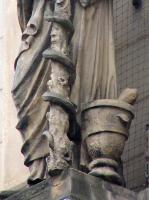
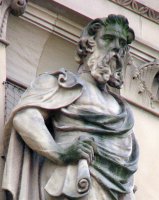
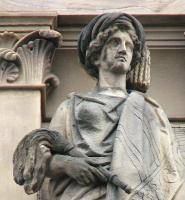
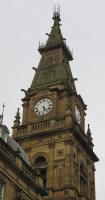
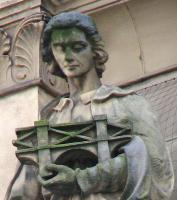
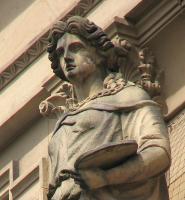
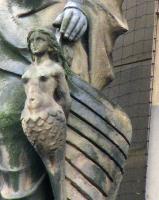
A truly grand and monumental pile, the creation of the Liverpool architect and Corporation Surveyor, John Weightman, and completed by the next Surveyor, E.R. Robson, put up in the 1860s, thus the best period of High Victorian architecture. To either side of the enormous central Renaissance style clock tower spread the wings, with terminal blocks, and adorned with numerous statues in pale sandstone. Some sources say there are 16 of them, but there are 18: three on the ranges left and right of the central portico, two on each of the terminal buildings, thus 10 in all facing Dale Street, and two pairs on each side of the building (to Crosshall Street on the left, Sir Thomas Street on the right as we face the Municipal Buildings), thus 18 altogether.
The statues are allegorical, but it takes a bit of interpretation to understand who they represent. My belief is that those on the front depict Liverpool’s produce (left hand range) and trade via ship (right hand range), to the four continents (left and right wings).
Liverpool Municipal Buildings, and reflection in a car windscreen.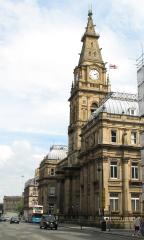

Looking at the front in Dale Street, starting from the left:
On the left wing we have two statues, both of girls with shields by their sides. She on the corner has a cross on her shield, which is held up by her left hand (i.e. on right hand side as we look at her). Her other hand, raised, has a hollow to show it held something once, likely a staff or sceptre, but is now empty. But I think we can safely place her as a statue of Europe, because upon her head she wears a castellated crown. Her face is somewhere between Greek and Victorian, with the nose not really Greek, the eyes more so, the mouth really rather Victorian, and the chin Greek again, the neck rather heavy. Like all the statues, she is Classically draped or robed. She has a loose shirt above, with soft collar, and broad sleeves held together with buttons and hanging down almost to the elbow. Her lower garment, wrapped around her waist and legs, forms a heavy blanket-like skirt or himation, and underneath we can see some thinner shift or chiton.
Her sister to the right is much more exotic. Her thick outer robe is carved with stripes and a patterned hem, and she wears a turban-like headdress at the front, with some thick tassel at the back hanging to one side. Her one hand is on her shield again, which bears a horse’s head carved in relief, and the other holds what might be a whisk, a short stick with some bunch of hair or fabric at the end. Who is she? Asia, I would think.
Next we have the three statues on the left range, the set back part of the building from the left wing. The first is a youthful girl with more slender neck and nice figure, carrying a cornucopia, or horn overflowing with fruit, which suggests she is emblematic of Plenty or Wealth. But her hair contains ears of corn, and though her other hand is empty, at her foot is the base of some broken tool which might be the base of a small plough or a tall sickle. So I think she may be an allegory of Agriculture or the Harvest, thus Liverpool as a centre for trade in agricultural produce. A very winsome and well conceived statue.
Next, in the centre of the range, is a male figure who seems to be representative of Manufacture, for he holds a section of an iron bridge cradled in his arm; again, his other hand has lost whatever it once held. His clothing suggests something more modern, a shirt or loose smock with buttons and sleeves, with a cloak, quite Classical, above it. The head is good, an expressive, slightly sombre face lined to right and left of the thin lips.
To the right is another woman, more solid than the first, with a spinning machine on a stool beside her, her hands raised to stretch an imaginary thread between them. Her eyes are closed, her face anything but Classical. Her arms though have a certain muscularity reminiscent of the ancient Greek, and the line of her upper arm from the strength around the elbow to her more slender wrist is particularly well carved.
So these three figures together can be taken as showing Liverpool as a port for the export of goods.
There are no central figures below the tall steeple, so we proceed to the three figures of the right-hand range. Surely the innermost figure is Navigation: a young woman holding up his sextant, while his other hand rests on the prow of a small ship, itself carved with a youthful mermaid. Classical drapery again, here worn as a tunic caught rather high above the waist. I like her pose, staring straight forward into the imagined distance, hair swept back by the wind, and wearing some cap or tiara on top.
Next, a man, with ringletted hair and full beard, the face as a whole though being bland rather than serious. He holds a telescope, and an unrolling scroll or chart, and by his feet rests a globe, so Astronomy I would think, though Navigation would be a possibility if that had not been taken by the previous figure. Classical drapery below, but above his belt, a buttoned and long sleeved top.
To the right, our third figure is a woman, with the boldest Classical drapery we have seen so far, and harmonious folds around her breasts. On has lost whatever it contained, but the other rests on a tall heap of parcels, so emblematic of Trade. Her face – that odd mix of Classical and Victorian, and with those cheeks and chin, I think she would not look out of place walking in the streets of Liverpool today.
Taking the three figures together, then, they represent Liverpool’s trade with the rest of the world.
Two figures again, both exotic. To the left, a savage, with ornaments in her hair, ears and two necklaces, and carrying a casket of further stones. Her face is rather masculine, with something of a scowl, the hands more delicate; the one not holding the casket clutches some broken tool. Her outer garment is fringed, adding to the exotic look, and not just her wrists but her ankles bear spiky bracelets. A good statue, and she must be Africa.
To the right, a more slender archer, with feathers in the hair, and holding an arrow; a quiverful can be seen behind the shoulder, and the figure holds a wavy bow. Matching Europe and Asia on the left Wing, and accompanying Africa, this statue is an image of America.
We start on the left, the furthest figure from Dale Street, with a powerfully built bearded man who represents Manufacturing or Engineering, a scroll or plan in one brawny fist, a great cogwheel to his other side; alas, his hand is lost, as is his foot.
Engineering and Building, perhaps.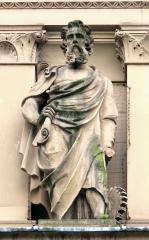
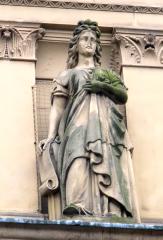
His female companion, the second of this pair of statues, also carries a scroll, unrolling, in front of a pillar on which she leans. Her other hand simply holds up her drapes under her breasts, and I think that pillar means she is emblematic of Building rather than Architecture, as we have another figure for that in a moment.
The second pair of figures on the Crosshall Street side of the Municipal Buildings are much easier to understand. First we have a girl holding thunderbolts, and with a generator beside her, with coils of wire and two dials to measure current, so she is undoubtedly Electricity. Really a very Classical figure compared to some in the set, which is appropriate. Her companion, closest to the corner with Dale Street, is a turbaned, bearded and rather thin man, holding a Staff of Aesculapius and with a pestle and mortar for grinding beside him, thus an allegorical figure of Medicine (see this page). Most characterful, and with splendidly undercut drapes.
Our first figure, furthest from Dale Street, holds callipers and a set square, and a scroll with a picture of some building, so he is an allegorical figure of Architecture. Alas, the width of the street is such that we cannot get a really good angle to view him from, but his drapery is again fine, especially over the arms.
His companion is a robust female figure, more medieval in her drapery than Classical. One hand is a little broken and has lost what it held, but we can presume it was a brush, for her other hand holds a palette – she is a figure of Painting, or more broadly, Art.
The left hand figure from the second pair is clearly Music – a girl holding a manuscript and a lyre. Again with good drapery, and perhaps the most well-carved hair of the set.
And our final figure, close to Dale Street, is a young man holding an open book, and resting his other hand on a small screw-press for printing – he is Literature.
So overall, if the Crosshall Street side figures of the Municipal Buildings broadly cover the knowledge and learning of Liverpool, then those on the Sir Thomas Street side – Architecture and Art, Music and Literature – cover the higher aspects of civilisation associated with the great city of Liverpool.
Other sculptural decoration on the building includes above all the four dragon-gargoyles above the clocks on the corners of the central tower, small female heads in roundels within squares below, panels with reliefs of stylised flowers, all this carving mostly on the central tower and of a size to give interest to the surface rather than be a feature in its own right, apart from the dragons. And we have much crocketing, pots and the Corinthian capitals of the many pillars and pilasters, mostly carved with ferns, apparently by the sculptor Thomas Earp, according to Pevsner.
Decorative scheme, capitals carved by T. Earp, gargoyle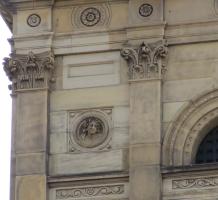

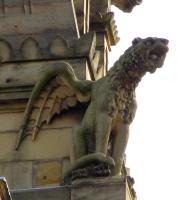
As for the rest of the building, to my eye it forms a grand whole, mostly Classical, though architectural commentators mournfully describe it as unclassifiable – I think they object to the tall steeple and those gargoyles on the central clock tower, which would nicely fit a Gothic church, and some of the minor detailing, which also has a tendency to the Gothic, rather than being offended by the French Mansard roofs, which after all were common enough in Edwardian Classical buildings. If we imagine whipping off the steeple and replacing it with several layers of pillars on a square or circular cross section, I think our commentators would be broadly content, but for me, and perhaps most Liverpudlians, it is fine just as it is.
Go back to sculpture of the month for September // Onwards to November
Liverpool's monument to Queen Victoria // Other sculpture in Liverpool // Sculpture in other English towns
Visits to this page from 1 Oct 2017: 2,630 since 4 October 2022